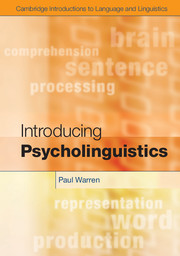Book contents
- Frontmatter
- Contents
- Figures
- Tables
- Preface
- Chapter 1 Introduction
- Chapter 2 Planning utterances
- Chapter 3 Finding words
- Chapter 4 Building words
- Chapter 5 Monitoring and repair
- Chapter 6 The use of gesture
- Chapter 7 Perception for language
- Chapter 8 Spoken word recognition
- Chapter 9 Visual word recognition
- Chapter 10 Syntactic sentence processing
- Chapter 11 Interpreting sentences
- Chapter 12 Making connections
- Chapter 13 Architecture of the language processing system
- Glossary
- References
- Index
Chapter 9 - Visual word recognition
Published online by Cambridge University Press: 05 November 2012
- Frontmatter
- Contents
- Figures
- Tables
- Preface
- Chapter 1 Introduction
- Chapter 2 Planning utterances
- Chapter 3 Finding words
- Chapter 4 Building words
- Chapter 5 Monitoring and repair
- Chapter 6 The use of gesture
- Chapter 7 Perception for language
- Chapter 8 Spoken word recognition
- Chapter 9 Visual word recognition
- Chapter 10 Syntactic sentence processing
- Chapter 11 Interpreting sentences
- Chapter 12 Making connections
- Chapter 13 Architecture of the language processing system
- Glossary
- References
- Index
Summary
PREVIEW
In this chapter we consider how readers access words from written or printed input. By the end of the chapter you should understand:
that reading involves both letter recognition and whole-word recognition;
that one route for reading involves converting spellings to sounds;
that the reading process can be affected by a range of types of dyslexia, which in turn provide important information about the skills involved in reading.
Introduction
Chapter 7 introduced some basic issues in perception, including issues that are relevant to the visual processing of written language. We saw that the visual perception of language involves a series of processing levels, including an input buffer for the visual stimulus, the transfer of information from there to working memory, and the linguistic interpretation of the analysed input. Studies of eye movements show that the input of text during reading involves a high level of control. In Chapter 8 we considered some of the key aspects of spoken word recognition. In this chapter we look at the processing of visual information in order to access words from written or printed input.
The chapter starts with a summary of some important factors that have been found to affect visual word recognition. It then briefly reviews three main attempts to capture some of these effects in word recognition models. This review includes comparison with the Cohort model of spoken word recognition outlined in the preceding chapter. We then consider one particular issue for reading aloud, the conversion of print to sound, which then leads to discussion of the dual-route model of reading. Finally, some principal types of dyslexia, or reading disability, are summarised, with reference to this model of reading.
- Type
- Chapter
- Information
- Introducing Psycholinguistics , pp. 139 - 156Publisher: Cambridge University PressPrint publication year: 2012

